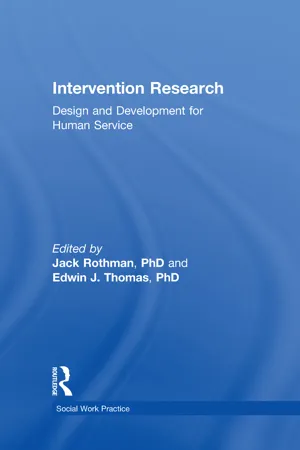
Intervention Research
Design and Development for Human Service
- 508 pages
- English
- ePUB (mobile friendly)
- Available on iOS & Android
About This Book
This interdisciplinary book presents a comprehensive conceptual and methodological treatment of intervention research, a developing area of empirical inquiry that aims to make research more directly relevant and applicable to practice. Intervention Research contains original chapters by the most highly regarded scholars in the field. These experts explain how to distinguish intervention research from other modalities, demonstrate a new model of research for the design and development of interventions, and provide guidelines for conducting intervention research in practice with individuals, families, and community organizations. Providing useful observations and a wealth of ideas, authors offer conceptual schemes, results from recent design and development studies, and strategies and methodologies to help professionals make their research more usable and meaningful. Chapters cover such important topics as the acquisition of relevant knowledge, meta-analysis in intervention research, methods and issues in designing and developing interventions, and field testing and evaluating innovative practice interventions. The book depicts intervention research through case illustrations and promotes the use of new technologies for developing innovative practice methods. Intervention Research focuses on Intervention Design and Development--the part of intervention research involving the creation of reliable, practical tools of social intervention in user-ready form. It sets forth systematic procedures for designing, testing, evaluating, and refining needed social technology and for disseminating proven techniques and programs to professionals in the community.Intervention Research has a base in social work, but is highly interdisciplinary. Authors contributing to this text come from a variety of fields, including psychology, sociology, education, information science, and communications. Professors and educators working in schools of public health, education, urban planning, nursing, and public administration, or teaching courses in psychology, sociology, or upper-level social work, will find this book full of comprehensive and practical information that is advantageous for their work.
Frequently asked questions
Information
and Promoting Innovation-
Handbook for Human Service
Professionals
• | Family and Child Advocacy Programs (social legislation, child advocacy councils) |
• | Family life education (shifting family roles, discipline, understanding feelings) |
• | Consultation to primary care-giving institutions (such as schools and community centers) |
• | Special services to high risk populations (minorities, preschoolers, the mentally retarded, the aging) |
• | Mobilizing community resources to assist families (coordination, general health care) |
• | Halfway houses and community placement (preparing patients for transition back into home and community) |
• | Support of natural, informal care-giving systems (neighborhood groups, opinion leaders) |
• | Outreach and decentralized services (hotlines, crisis intervention) |
• | Encouraging meaningful community participation and problem solving by families (social action, creative use of leisure). |
Table of contents
- Cover Page
- Half Title page
- Series page
- Title Page
- Copyright Page
- Contents
- About the Editors
- About the Contributors
- Foreword
- Preface
- Conceptual Overview
- Problem Analysis and Project Planning
- Information Gathering and Synthesis
- Design
- Early Development and Pilot Testing
- Evaluation and Advanced Development
- Dissemination
- Appendixes: Illustrative Practice Tools-Design and Development Products of Intervention Research
- Subject Index
- Name Index